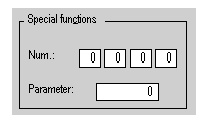|
How to configure a special function (TSX CTY2C)
|
|
|
(Original Document)
|
|
Function No.
|
Description
|
Version
module
|
|---|---|---|
|
1
|
Time lapsed between the last pulse and a hardware capture occurrence.
|
1.0
|
|
2
|
Triggering a direct and synchronized capture and preset with each rising edge of the programmable frequency output.
|
1.0
|
|
3
|
Speed checks correct and moving part stationary.
|
1.1
|
|
Funct. No. 1
|
Funct. No. 2
|
Funct. No. 3
|
|
|---|---|---|---|
|
Funct. No. 1
|
-
|
Non exclusive (1)
|
Exclusive
|
|
Funct. No. 2
|
Non exclusive (1)
|
-
|
Exclusive
|
|
Funct. No. 3
|
Exclusive
|
Exclusive
|
-
|
|
Step
|
Action
|
|---|---|
|
1
|
Open the module to be configured.
|
|
2
|
In the channel field: select the counter (i.e. the channel) concerned.
|
|
3
|
In the general parameters field: select the counting function and the task.
Result: the configuration screen appears.
|
|
4
|
In the Special functions zone, enter the number of the special function in one of the Num fields.
 Enter the number of the second special function, if necessary. A zero means that no function has been selected.
|
|
5
|
Complete the Parameter field if necessary, for special function number 3 for example.
|
|
6
|
Special function(s) configuration is complete.
If there are no more parameters to configure, enable the new configuration. To do this:
|